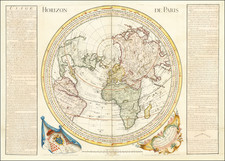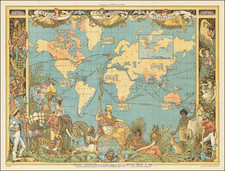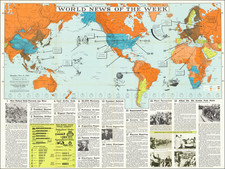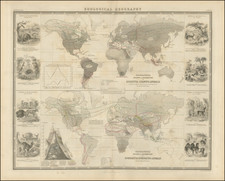Rare Wall Map of the World By Rigobert Bonne
Rare separately issued wall map of the world, published in the 12th year of the French Revolution by Delamarche.
This very large, attractive double-hemisphere map of the world depicts Greenland and the Arctic attached to North America. In North America, a Northwest Passage connects Hudson Bay with the Pacific through a network of rivers and lakes.
The United States is named and confined along the eastern seaboard, and the western region is mostly blank with a few place names including C. Mendocino and Pt. de Drake ou de St. Francois. Captain Cook's expeditions are prominently depicted with Alaska beginning to take shape.
Tasmania is shown as an island and both islands of New Zealand are depicted. Surrounded by elaborate decorative elements.
We note also an edition of 1775 in the British Library and an edition of 1788, but all editions are rare.
Rigobert Bonne (1727-1794) was an influential French cartographer of the late-eighteenth century. Born in the Lorraine region of France, Bonne came to Paris to study and practice cartography. He was a skilled cartographer and hydrographer and succeeded Jacques Nicolas Bellin as Royal Hydrographer at the Depot de la Marine in 1773. He published many charts for the Depot, including some of those for the Atlas Maritime of 1762. In addition to his work at the Depot, he is best known for his work on the maps of the Atlas Encyclopedique (1788) which he did with Nicholas Desmarest. He also made the maps for the Abbe Raynals’ famous Atlas de Toutes Les Parties Connues du Globe Terrestre (1780).
More than his individual works, Bonne is also important for the history of cartography because of the larger trends exemplified by his work. In Bonne’s maps, it is possible to see the decisive shift from the elaborate decorations of the seventeenth century and the less ornate, yet still prominent embellishments of the early to mid-eighteenth century. By contrast, Bonne’s work was simple, unadorned, and practical. This aesthetic shift, and the detail and precision of his geography, make Bonne an important figure in mapping history.












![[ Volcanic Regions ] Geografia Dei Vulcani Accesi Ed Estinti](https://storage.googleapis.com/raremaps/img/small/101861.jpg)


![[ World Map Facsimile ] Typus Universalis Terrae, Iuxta Modernorum Distinctionem et Extensionem Per Regna et Provincias](https://storage.googleapis.com/raremaps/img/small/95596.jpg)
